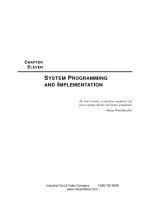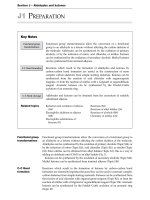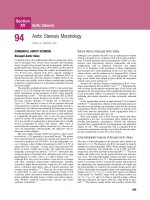Ebook Netter''s concise radiologic anatomy (2nd edition): Part 2
Bạn đang xem bản rút gọn của tài liệu. Xem và tải ngay bản đầy đủ của tài liệu tại đây (39.54 MB, 255 trang )
4
Section 4
Abdomen
4
Rectus Abdominis
Rectus abdominis muscle
Tendinous intersections
Inguinal ligament
Muscles of the anterior abdominal wall (Atlas of Human Anatomy, 6th edition,
Plate 246)
Clinical Note Surgical incisions through the rectus abdominis can be made
transversely because the abdominal nerves run in that direction and the
healed scar appears very similar to one of the many tendinous intersections
within the muscle.
222
Abdomen
Rectus Abdominis
Rectus abdominis
muscle
Tendinous intersections
Inguinal ligament
Curved coronal reconstruction, abdominal CT
• The rectus sheath is composed of the aponeuroses of the abdominal muscles.
• The inguinal ligament (Poupart’s) is the thickened inferior border of the external
oblique aponeurosis.
Abdomen
223
4
4
Anterior Abdominal Wall Muscles
Rectus sheath
Rectus abdominis muscle
Linea alba
External oblique muscle
Internal oblique muscle
Transversus abdominis muscle
Cross section of the muscles of the anterior abdominal wall (Atlas of Human
Anatomy, 6th edition, Plate 248)
Clinical Note Because of the dense fascia investing the rectus muscles,
a rectus sheath hematoma, which may occur after muscle injury in a patient
with coagulopathy, develops within a tight, nonelastic space and can become
remarkably firm.
224
Abdomen
Anterior Abdominal Wall Muscles
External oblique muscle
Rectus abdominis muscle
Internal oblique muscle
Linea alba
Transversus
abdominis muscle
Axial section, abdominal CT
• The linea alba is composed of the interweaving fibers of the aponeuroses of the
abdominal muscles and is important surgically because longitudinal incisions in it
are relatively bloodless.
• The composition of the anterior and posterior layers of the rectus sheath changes
superior and inferior to the arcuate line (of Douglas), which is where the inferior
epigastric artery enters the sheath.
Abdomen
225
4
4
Abdominal Wall, Superficial View
Internal thoracic vein
Thoracoepigastric vein
Paraumbilical veins
Veins of the anterior abdominal wall (Atlas of Human Anatomy, 6th edition, Plate 252)
Clinical Note Varicosity of the paraumbilical veins is associated with portal
hypertension (often caused by cirrhosis) and is termed caput medusa.
Varicosity of the thoracoepigastric vein is similarly associated with portal
hypertension and also with increased pressure or obstruction in the IVC
because blood from the lower body then uses this vein to return blood to the
heart via the SVC.
226
Abdomen
Abdominal Wall, Superficial View
Abdominal wall
collaterals
Thoracoepigastric vein
Paraumbilical veins
Coronal volume rendered, CE CT of the superficial abdominal wall veins (From
Lawler LP, Fishman EK: Thoracic venous anatomy: Multidetector row CT evaluation. Radiol
Clin North Am 41(3):545-560, 2003)
• Abdominal wall collaterals join the internal thoracic (mammary) and lateral thoracic
veins to return venous blood to the vena cava.
• The paraumbilical veins communicate with the portal vein via the vein in the
ligamentum teres hepatis (round ligament of the liver).
• When pathology obstructs normal flow, collateral vessels may dilate and become
tortuous as shown in this CT.
Abdomen
227
4
4
Inguinal Region
Plane of section
Inferior epigastric
artery and vein
External iliac artery
and vein
Peritoneum
Urinary
bladder
Anterior view of the inguinal region (Atlas of Human Anatomy, 6th edition, Plate 257)
Clinical Note When the bladder fills, it expands in the extraperitoneal space
between the peritoneum and the abdominal wall. Thus, the bladder may be
penetrated (suprapubic cystotomy) for removal of urinary calculi, foreign
bodies, or small tumors without entering the peritoneal cavity.
228
Abdomen
Inguinal Region
External iliac artery and vein
Rectus abdominis
muscle
Inferior epigastric
artery and vein
Urinary
bladder
Oblique axial 6-mm thick MIP, CE CT of the abdomen and pelvis (red lines in the
reference images indicate the position and orientation of the main image)
• The inferior epigastric vessels are an important landmark for differentiating
between indirect and direct inguinal hernias. Pulsations from the artery can be felt
medial to the neck of an indirect hernia and lateral to the neck of a direct hernia.
• The inferior epigastric vessels enter the rectus sheath approximately at the
arcuate line, which is where the formation of the sheath changes. Inferior to the
line the aponeuroses of all of the abdominal muscles pass anterior to the rectus
abdominis muscle whereas superior to the line, half of the aponeurosis of the
internal oblique muscle and all of the aponeurosis of the transversus abdominis
pass posterior to the rectus muscle.
Abdomen
229
4
4
Quadratus Lumborum
Quadratus lumborum
muscle
Transversus abdominis
muscle
Iliacus muscle
Muscles of the posterior abdominal wall (Atlas of Human Anatomy, 6th edition,
Plate 258)
Clinical Note Grey-Turner’s sign, ecchymosis in the flank resulting from
retroperitoneal hemorrhage (most often from hemorrhagic pancreatitis), occurs
as the blood spreads from the anterior pararenal space to between the two
leaves of the posterior renal fascia and subsequently to the lateral edge of the
quadratus lumborum muscle.
230
Abdomen
Quadratus Lumborum
Lung
Liver
Spleen
Transversus abdominis
muscle
Twelfth rib
Quadratus lumborum
muscle
Curved coronal reconstruction, thoracolumbar CT
• The quadratus lumborum muscle primarily laterally flexes the trunk when acting
unilaterally.
• The quadratus lumborum muscle attaches to the 12th rib and thereby can act as
an accessory respiratory muscle by allowing the diaphragm to exert greater
downward force by preventing upward movement of the 12th rib.
Abdomen
231
4
4
Psoas Major
Transversus abdominis
muscle
Quadratus lumborum
muscle
Psoas minor muscle
Psoas major muscle
Iliacus muscle
Muscles of the posterior abdominal wall (Atlas of Human Anatomy, 6th edition,
Plate 258)
Clinical Note A psoas abscess usually results from disease of the lumbar
vertebrae, with the pus descending into the muscle sheath; it may cause
swelling in the proximal thigh that refers pain to the hip, thigh, or knee.
The infection is most commonly tuberculous or staphylococcal. Before the
discovery of antibiotics, these infections were life threatening.
232
Abdomen
Psoas Major
Liver
Kidney
Psoas major muscle
Iliacus muscle
Bladder
Curved coronal reconstruction, abdominal CT
• The psoas major muscle is a primary flexor of the trunk.
• The psoas minor is an inconstant muscle that inserts onto the pubis; the major
inserts onto the lesser trochanter.
Abdomen
233
4
4
Kidneys, Normal and Transplanted
Renal arteries
Superior mesenteric artery
Inferior mesenteric artery
Common iliac artery
External iliac artery
Arteries of the posterior abdominal wall (Atlas of Human Anatomy, 6th edition,
Plate 259)
Clinical Note A transplanted kidney is typically placed in the pelvis and its
associated artery is attached to the external iliac artery, although it may also
be attached to the common iliac artery as shown in the MR image.
234
Abdomen
Kidneys, Normal and Transplanted
Splenic artery
Common hepatic
artery
Superior mesenteric
artery
Faint outline of the
transplanted kidney
Transplanted renal
artery attached to
right common
iliac artery
Right common
iliac artery
Coronal MIP, CE MRA of renal transplant surveillance (From McGuigan EA, Sears ST,
Corse WR, Ho VB: MR angiography of the abdominal aorta. Magn Reson Imaging Clin N Am
13(1):65-89, 2005)
• Patency of the anastomosis (connection) of the iliac artery to the transplanted
renal artery is demonstrated.
• The indication for kidney transplantation is end-stage renal disease (ESRD).
Diabetes is the most common cause of ESRD, followed by glomerulonephritis.
• Potential recipients of kidney transplants undergo an extensive immunologic
evaluation to minimize transplants that are at risk for antibody-mediated
hyperacute rejection.
• The left kidney is the one preferred for transplant because of its longer vein
compared to the right.
Abdomen
235
4
4
Abdominal Regions
Right and left lateral rectus (semilunar) planes
Left and right midclavicular lines
1
2
3
4
5
6
7
8
9
10
T12
L1
L2
L3
Transverse colon
Transpyloric plane
Subcostal plane
Descending colon
Umbilical region
Ascending colon
L5
Intertubercular plane
Interspinous plane
Relationships of the abdominal viscera to the abdominal regions (Atlas of Human
Anatomy, 6th edition, Plate 244)
Clinical Note The umbilical region remains a region of abdominal muscle
weakness after birth, and umbilical or paraumbilical hernias can develop at
any age.
236
Abdomen
Abdominal Regions
Transverse colon
T12
Descending colon
Ascending colon
Umbilical region
L5
Volume rendered display, abdominal CT
• Classically, the abdomen is divided into four quadrants defined by vertical and
horizontal planes through the umbilicus. More recently, it has been divided into
nine regions based on subcostal, transtubercular, and right and left lateral rectus
(semilunar) planes.
• Note the greater height of the left colic (splenic) flexure compared to the hepatic
flexure on the right.
Abdomen
237
4
4
Appendix
Transverse colon
(elevated)
Mesocolon
Ascending
colon
Cecum
Sigmoid colon
Vermiform
appendix
Appendix, large bowel, mesocolon (Atlas of Human Anatomy, 6th edition, Plate 265)
Clinical Note Appendicitis is a common cause of acute abdominal pain,
which usually begins in the periumbilical region and migrates to the right
lower quadrant because of associated peritoneal irritation.
238
Abdomen
Appendix
Ascending colon
Cecum
Vermiform appendix
Small bowel
Sigmoid colon
Oblique coronal reconstruction, abdominal CT
• Inspissated bowel contents may lead to development of an appendolith, which is
a calcified concretion that may obstruct the proximal lumen of the appendix;
stasis, bacterial overgrowth, infection, and swelling (i.e., appendicitis) may follow,
as can eventual rupture.
• The appendix is highly variable in its location, including occasionally being
posterior to the cecum (retrocecal).
Abdomen
239
4
4
Abdomen, Upper Viscera
Subphrenic recess
Stomach
Diaphragm
Spleen
Liver
Pancreas
Left kidney
Descending (second) part of duodenum
Upper abdominal viscera with stomach reflected thus revealing the omental bursa
(Atlas of Human Anatomy, 6th edition, Plate 266)
Clinical Note A collection of pus between the diaphragm and the liver is
known as a subphrenic abscess and may be secondary to the following:
(1) peritonitis following a perforated peptic ulcer, appendicitis, pelvic
inflammatory disease, or infection subsequent to cesarean section; (2) trauma
that ruptures a hollow viscus and contaminates the peritoneal cavity; (3) a
laparotomy during which the peritoneal cavity is contaminated; and (4) a
ruptured liver abscess. Treatment is placement of a drainage tube until the
abscess heals.
240
Abdomen
Abdomen, Upper Viscera
Diaphragm
Subphrenic recess
Liver
Stomach
Spleen
Pancreas
Descending (second)
part of duodenum
Left kidney
Vasa recta (terminal
branches) of superior
mesenteric artery
Oblique coronal slab, volume rendered display, abdominal CT
• The right kidney is not apparent in this image because of the obliquity of the
image (the plane of the “coronal” image is angled so that it passes anterior to the
right kidney but through the left kidney).
• The vasa recta (terminal branches) of the superior mesenteric artery (SMA) supply
loops of small bowel.
• The terminal or fourth segment of the duodenum is attached to the diaphragm by
a variable band of smooth muscle known as the suspensory ligament of the
duodenum (ligament of Treitz). It is not recognizable on CT images.
Abdomen
241
4
4
Omental Bursa, Oblique Section
Vertebral body of L1
Spleen
Abdominal aorta
Inferior vena cava
Pancreas
Stomach
Omental (epiploic)
foramen (of Winslow)
Duodenum
Omental bursa (lesser sac)
Oblique section at the level of the first lumbar vertebra (Atlas of Human Anatomy,
6th edition, Plate 267)
Clinical Note Ascites is an accumulation of excess fluid in the peritoneal
cavity. The finding of a disproportionate amount of ascites in the bursa may
help narrow the differential diagnosis to organs bordering the lesser sac.
242
Abdomen
Omental Bursa, Oblique Section
Vertebral body of L1
Spleen
Abdominal aorta
Inferior vena cava
Pancreas
Omental bursa
Stomach
Volume rendered display, CE CT of the abdomen
• The omental bursa, also known as the lesser sac, is the portion of the peritoneal
cavity that is directly posterior to the stomach.
• The only natural connection between the omental bursa and the remainder of the
peritoneal cavity (greater sac) is the epiploic foramen (of Winslow).
Abdomen
243
4
4
Stomach, In Situ
Fundus of
stomach
Body of stomach
Pyloric valve
Pyloric antrum
Duodenal
bulb
Hypertonic stomach
Orthotonic stomach
Hypotonic stomach
Atonic stomach
Stomach with liver and gallbladder elevated (top); variations in positions of the
stomach (bottom) (Atlas of Human Anatomy, 6th edition, Plate 269)
Clinical Note Adjustable gastric banding, or lap band surgery, is a form of
restrictive weight loss surgery (bariatric surgery) for morbidly obese patients
with a body mass index (BMI) of 40 or more. The gastric band is an inflatable
silicone prosthetic device that is laproscopically placed around the fundus
of the stomach to reduce the amount of food that can be ingested at any
one time.
244
Abdomen
Stomach, In Situ
Body of stomach
Duodenal bulb
Pyloric valve
Gastric antrum
Gastric rugae
Oblique curved CE CT of the abdomen
• The stomach is filled with whole milk in this patient, the fat content of which
decreases the CT density of the stomach fluid in order to enhance contrast
differences with other tissues, such as the stomach wall. Note that the pyloric
valve is closed, as it is most of the time.
• The position of the stomach is variable in relation to the body habitus. This patient
has an “orthotonic” stomach.
• The term gastric antrum is a clinical term referring to the distal part of the
stomach immediately proximal to the pyloric valve (pylorus). Anatomically, this part
of the stomach would be referred to as the gastric antrum.
Abdomen
245
4









